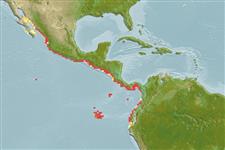Issue
Anchoviella parri Hildebrand, 1943 could be a valid species according to Castro-Aguirre et al. (2005) (also Ref. 189).
Environment: milieu / climate zone / depth range / distribution range
Ecología
marino; salobre; rango de profundidad 1 - 60 m (Ref. 96339). Subtropical; 29°N - 6°S, 113°W - 77°W (Ref. 189)
Eastern Central Pacific: southwestern coast of Baja California, Mexico and the Gulf of California to Puerto Pizarro, Peru.
Tamaño / Peso / Age
Maturity: Lm ? range ? - ? cm
Max length : 13.2 cm SL macho / no sexado; (Ref. 9298); common length : 10.0 cm SL macho / no sexado; (Ref. 9298)
Short description
Claves de identificación | Morfología | Morfometría
Espinas dorsales (total) : 0; Espinas anales: 0; Radios blandos anales: 18 - 23. Body moderately elongate, but somewhat compressed. Snout fairly short, about 3/4 eye diameter; maxilla moderate, tip somewhat bluntly pointed, reaching to inter-operculum; gill cover canals of panamensis-(Mexico) or walkeri-type. Anal fin fairly long, its origin below or a little behind midpoint of dorsal fin base. A narrow silver stripe along flank, about 1/2 eye diameter.
Occurs in coastal waters, but most often recorded from bays, lagoons and estuaries, thus able to tolerate lowered salinities. Forms schools (Ref. 9298).
Life cycle and mating behavior
Maturities | Reproducción | Spawnings | Egg(s) | Fecundities | Larva
Spawn in school (Ref. 205).
Whitehead, P.J.P., G.J. Nelson and T. Wongratana, 1988. FAO Species Catalogue. Vol. 7. Clupeoid fishes of the world (Suborder Clupeoidei). An annotated and illustrated catalogue of the herrings, sardines, pilchards, sprats, shads, anchovies and wolf-herrings. FAO Fish. Synop. 125(7/2):305-579. Rome: FAO. (Ref. 189)
IUCN Red List Status (Ref. 130435)
Threat to humans
Harmless
Human uses
Herramientas
Special reports
Download XML
Fuentes de Internet
Estimates based on models
Preferred temperature (Ref.
123201): 23 - 28.8, mean 26.4 °C (based on 48 cells).
Phylogenetic diversity index (Ref.
82804): PD
50 = 0.5000 [Uniqueness, from 0.5 = low to 2.0 = high].
Bayesian length-weight: a=0.00661 (0.00383 - 0.01141), b=3.03 (2.88 - 3.18), in cm total length, based on LWR estimates for this species & Genus-body shape (Ref.
93245).
Nivel trófico (Ref.
69278): 3.4 ±0.4 se; based on size and trophs of closest relatives
Resiliencia (Ref.
120179): Alto, población duplicada en un tiempo mínimo inferior a 15 meses (Preliminary K or Fecundity.).
Fishing Vulnerability (Ref.
59153): Low vulnerability (10 of 100).
